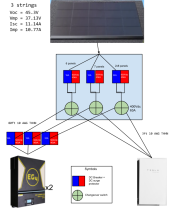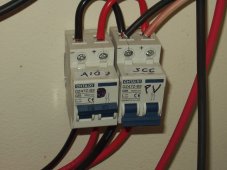solarhombre
New Member
Hi there.
I have 11.6kWh Tesla T400H panels + 7.6kWh Tesla inverter installed. Recently I added 2xEG4 6500 and 6xEG4-LLv2 rack batteries.
In order to have solar power in case of a grid power outage, I would like to be able to manually switch the solar panels output from feeding the Tesla inverter to feeding the EG4 6500s.
This is the idea I've come up with (see pic below):
* Move the wires coming down from the solar panels from the Tesla inverter to a new metallic electrical box.
* The two wires from each of the three strings go to a breaker (500V, 16A for two of the strings, 32A for one paralleled string).
* The output from the above breakers goes to:
1) newly installed surge protector devices (SPD), 600Vdc, 40kA, which works fine for the Tesla inverter.
2) newly installed changeover switches, one per string. The manual changeover switches (MTS) I found are 400Vdc and 63A.
* In each MTS:
-Position 1 sends to power to the Tesla inverter (default)
-Position 2 sends the power to the EG4 inverters (emergency)
I have to run about 70ft of EMT conduit from where the PV wires currently connect to the Tesla inverter to the garage, where the EG4 6500s are. Once in the garage, the wires go through 3 breakers and SPDs. Maybe these SPDs here are redundant, but there's >70ft of wire run that could cause trouble. These SPDs are 500Vdc, 40kA because the EG4 max input voltage is 500V.
Other than being able to replenish the batteries during a power outage, I might also be able to squeeze some more power from the same panels when the Tesla inverter is clipping (>5h/d between April and August at this latitude!)
Am I missing anything? Specially if related to safety/code compliance. Any way of achieving the same goals and a simpler design? Would you improve anything?
Looking forward to your comments/advice/chides
TIA.

I have 11.6kWh Tesla T400H panels + 7.6kWh Tesla inverter installed. Recently I added 2xEG4 6500 and 6xEG4-LLv2 rack batteries.
In order to have solar power in case of a grid power outage, I would like to be able to manually switch the solar panels output from feeding the Tesla inverter to feeding the EG4 6500s.
This is the idea I've come up with (see pic below):
* Move the wires coming down from the solar panels from the Tesla inverter to a new metallic electrical box.
* The two wires from each of the three strings go to a breaker (500V, 16A for two of the strings, 32A for one paralleled string).
* The output from the above breakers goes to:
1) newly installed surge protector devices (SPD), 600Vdc, 40kA, which works fine for the Tesla inverter.
2) newly installed changeover switches, one per string. The manual changeover switches (MTS) I found are 400Vdc and 63A.
* In each MTS:
-Position 1 sends to power to the Tesla inverter (default)
-Position 2 sends the power to the EG4 inverters (emergency)
I have to run about 70ft of EMT conduit from where the PV wires currently connect to the Tesla inverter to the garage, where the EG4 6500s are. Once in the garage, the wires go through 3 breakers and SPDs. Maybe these SPDs here are redundant, but there's >70ft of wire run that could cause trouble. These SPDs are 500Vdc, 40kA because the EG4 max input voltage is 500V.
Other than being able to replenish the batteries during a power outage, I might also be able to squeeze some more power from the same panels when the Tesla inverter is clipping (>5h/d between April and August at this latitude!)
Am I missing anything? Specially if related to safety/code compliance. Any way of achieving the same goals and a simpler design? Would you improve anything?
Looking forward to your comments/advice/chides
TIA.




